Page 247 of 878
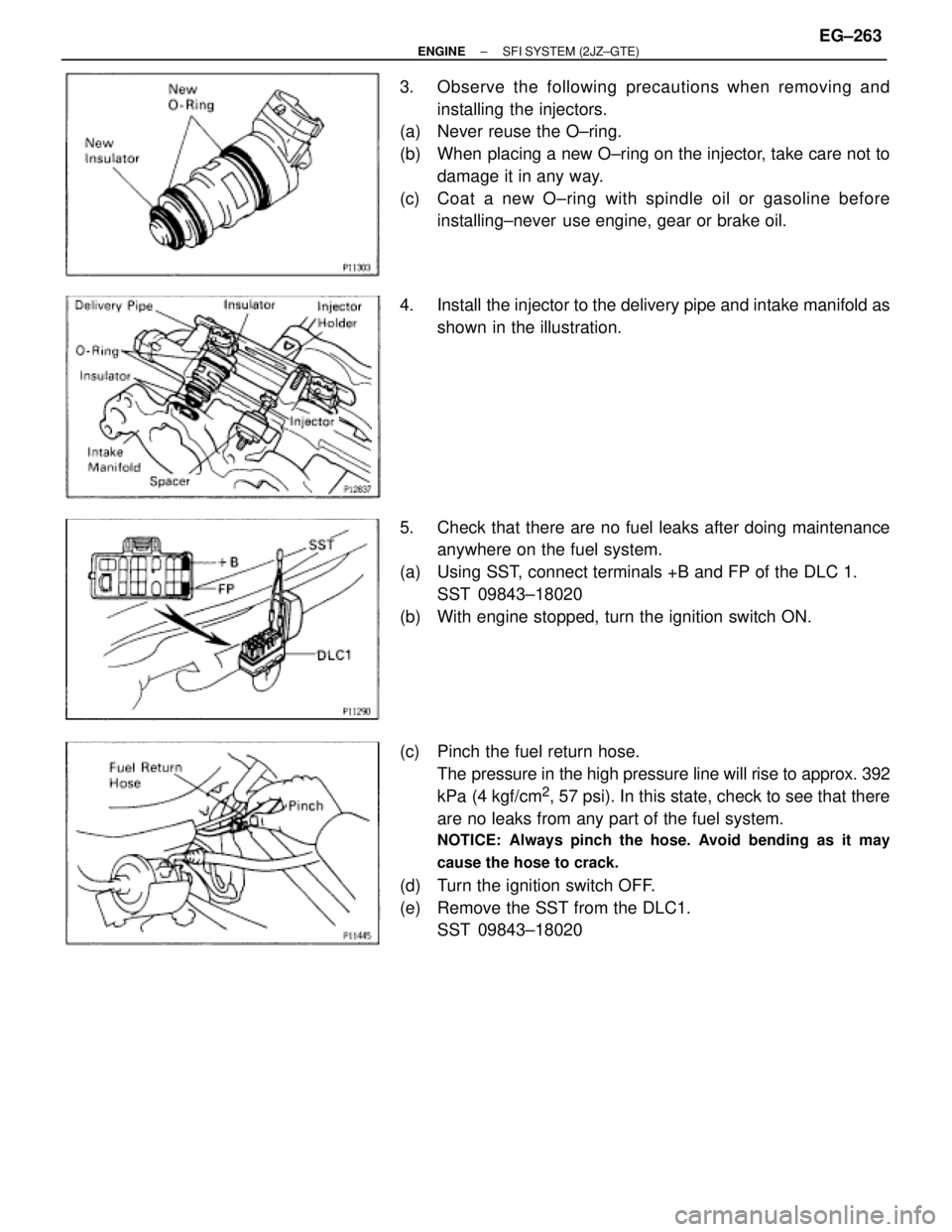
3. Observe the following precautions when removing and
installing the injectors.
(a) Never reuse the O±ring.
(b) When placing a new O±ring on the injector, take care not to
damage it in any way.
(c) Coat a new O±ring with spindle oil or gasoline before
installing±never use engine, gear or brake oil.
4. Install the injector to the delivery pipe and intake manifold as
shown in the illustration.
5. Check that there are no fuel leaks after doing maintenance
anywhere on the fuel system.
(a) Using SST, connect terminals +B and FP of the DLC 1.
SST 09843±18020
(b) With engine stopped, turn the ignition switch ON.
(c) Pinch the fuel return hose.
The pressure in the high pressure line will rise to approx. 392
kPa (4 kgf/cm
2, 57 psi). In this state, check to see that there
are no leaks from any part of the fuel system.
NOTICE: Always pinch the hose. Avoid bending as it may
cause the hose to crack.
(d) Turn the ignition switch OFF.
(e) Remove the SST from the DLC1.
SST 09843±18020
± ENGINESFI SYSTEM (2JZ±GTE)EG±263
Page 248 of 878
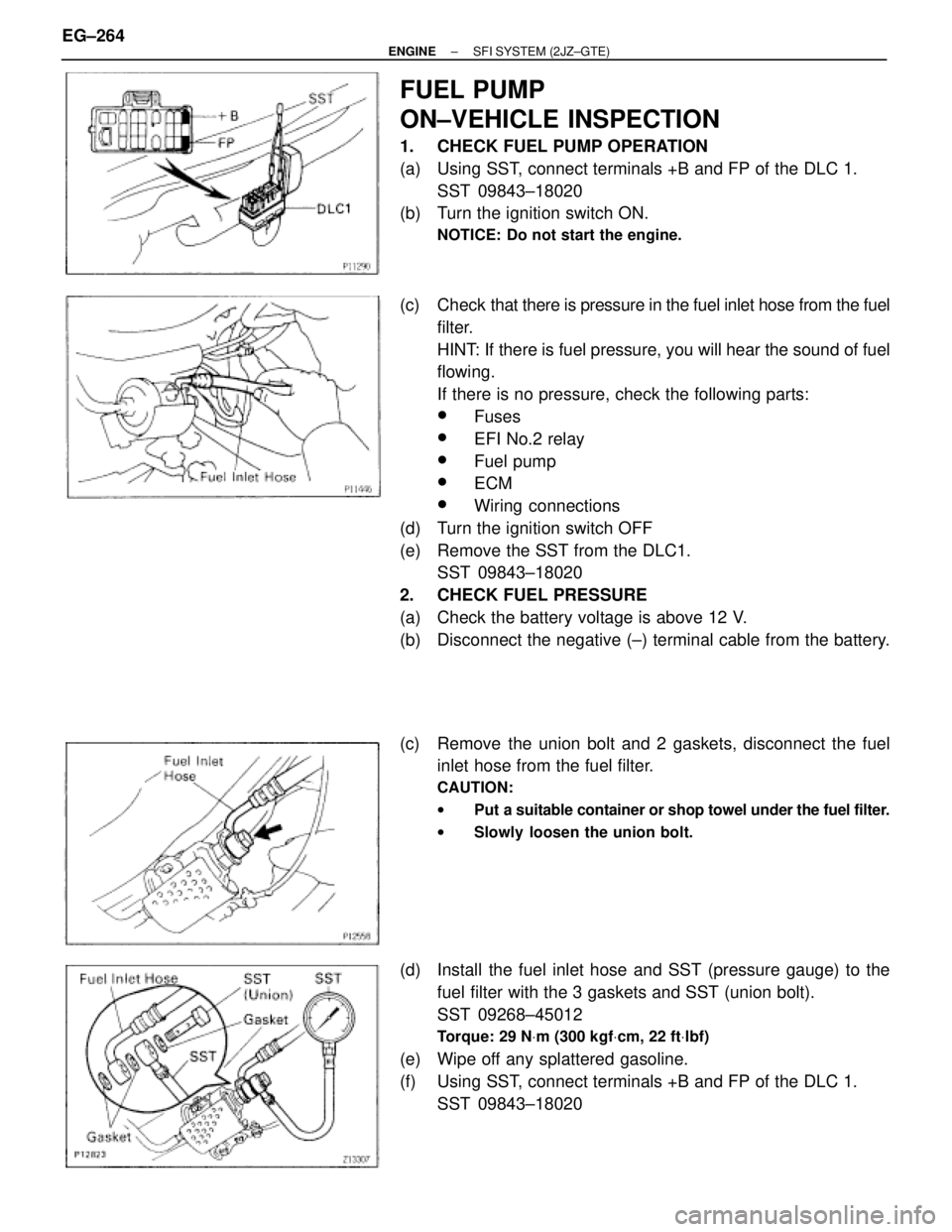
FUEL PUMP
ON±VEHICLE INSPECTION
1. CHECK FUEL PUMP OPERATION
(a) Using SST, connect terminals +B and FP of the DLC 1.
SST 09843±18020
(b) Turn the ignition switch ON.
NOTICE: Do not start the engine.
(c) Check that there is pressure in the fuel inlet hose from the fuel
filter.
HINT: If there is fuel pressure, you will hear the sound of fuel
flowing.
If there is no pressure, check the following parts:
wFuses
wEFI No.2 relay
wFuel pump
wECM
wWiring connections
(d) Turn the ignition switch OFF
(e) Remove the SST from the DLC1.
SST 09843±18020
2. CHECK FUEL PRESSURE
(a) Check the battery voltage is above 12 V.
(b) Disconnect the negative (±) terminal cable from the battery.
(c) Remove the union bolt and 2 gaskets, disconnect the fuel
inlet hose from the fuel filter.
CAUTION:
wPut a suitable container or shop towel under the fuel filter.
wSlowly loosen the union bolt.
(d) Install the fuel inlet hose and SST (pressure gauge) to the
fuel filter with the 3 gaskets and SST (union bolt).
SST 09268±45012
Torque: 29 NVm (300 kgfVcm, 22 ftVlbf)
(e) Wipe off any splattered gasoline.
(f) Using SST, connect terminals +B and FP of the DLC 1.
SST 09843±18020 EG±264
± ENGINESFI SYSTEM (2JZ±GTE)
Page 249 of 878
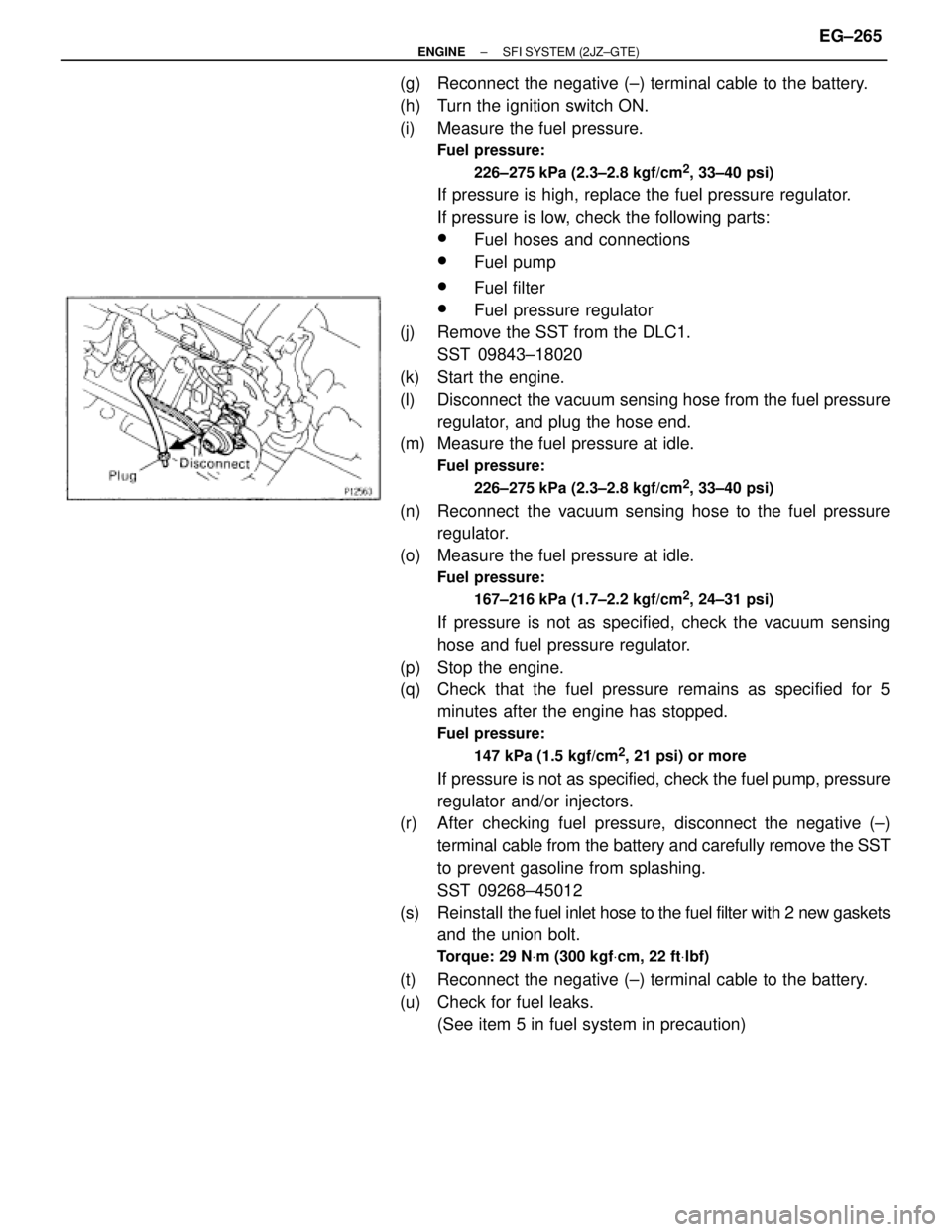
(g) Reconnect the negative (±) terminal cable to the battery.
(h) Turn the ignition switch ON.
(i) Measure the fuel pressure.
Fuel pressure:
226±275 kPa (2.3±2.8 kgf/cm
2, 33±40 psi)
If pressure is high, replace the fuel pressure regulator.
If pressure is low, check the following parts:
wFuel hoses and connections
wFuel pump
wFuel filter
wFuel pressure regulator
(j) Remove the SST from the DLC1.
SST 09843±18020
(k) Start the engine.
(l) Disconnect the vacuum sensing hose from the fuel pressure
regulator, and plug the hose end.
(m) Measure the fuel pressure at idle.
Fuel pressure:
226±275 kPa (2.3±2.8 kgf/cm
2, 33±40 psi)
(n) Reconnect the vacuum sensing hose to the fuel pressure
regulator.
(o) Measure the fuel pressure at idle.
Fuel pressure:
167±216 kPa (1.7±2.2 kgf/cm
2, 24±31 psi)
If pressure is not as specified, check the vacuum sensing
hose and fuel pressure regulator.
(p) Stop the engine.
(q) Check that the fuel pressure remains as specified for 5
minutes after the engine has stopped.
Fuel pressure:
147 kPa (1.5 kgf/cm
2, 21 psi) or more
If pressure is not as specified, check the fuel pump, pressure
regulator and/or injectors.
(r) After checking fuel pressure, disconnect the negative (±)
terminal cable from the battery and carefully remove the SST
to prevent gasoline from splashing.
SST 09268±45012
(s) Reinstall the fuel inlet hose to the fuel filter with 2 new gaskets
and the union bolt.
Torque: 29 NVm (300 kgfVcm, 22 ftVlbf)
(t) Reconnect the negative (±) terminal cable to the battery.
(u) Check for fuel leaks.
(See item 5 in fuel system in precaution)
± ENGINESFI SYSTEM (2JZ±GTE)EG±265
Page 254 of 878
(e) Temporarily install the retainer.
(f) Using SST, tighten the retainer until the arrow mark on
retainer is within the lines on the fuel tank.
SST 09808±14010
(g) Check that the arrow marks of the fuel pump bracket and fuel
tank are aligned.
(h) Install the retainer clamp.
(i) Connect the connector and hoses to the fuel pump bracket:
wFuel pump connector
wFuel outlet hose
Connect the outlet hose with 2 new gaskets and the union
bolt.
Torque: 29 NVm (300 kgfVcm, 22 ftVlbf)
wFuel return hose
wFuel breather hose
2. INSTALL SERVICE HOLE COVER
3. INSTALL SPARE WHEEL
4. INSTALL SPARE WHEEL COVER
5. INSTALL FLOOR CARPET
6. CHECK FOR FUEL LEAKS
(See item 5 in fuel system in precaution) EG±270
± ENGINESFI SYSTEM (2JZ±GTE)
Page 256 of 878
FUEL PRESSURE REGULATOR
INSTALLATION
1. INSTALL FUEL PRESSURE REGULATOR
(a) Apply a light coat of gasoline to a new O±ring, and install it
to the pressure regulator.
(b) Attach the pressure regulator to the delivery pipe.
(c) Check that the pressure regulator rotates smoothly.
NOTICE: If it does not rotate smoothly, the O±ring may be
pinched, so remove the pressure regulator and do steps (b)
and (c) above again.
(d) Install the pressure regulator with the 2 bolts.
Torque: 8.8 NVm (90 kgfVcm, 78 in.Vlbf)
2. CONNECT FUEL RETURN PIPE TO FUEL PRESSURE
REGULATOR
Install the return pipe with 2 new gaskets and the union bolt.
Torque: 27 NVm (280 kgfVcm, 20 ftVlbf)
3. CONNECT VACUUM SENSING HOSE TO FUEL
PRESSURE REGULATOR
4. INSTALL THROTTLE BODY
(See throttle body installation)
5. CHECK FOR FUEL LEAKS
(See item 5 in fuel system in precaution) EG±272
± ENGINESFI SYSTEM (2JZ±GTE)
Page 257 of 878
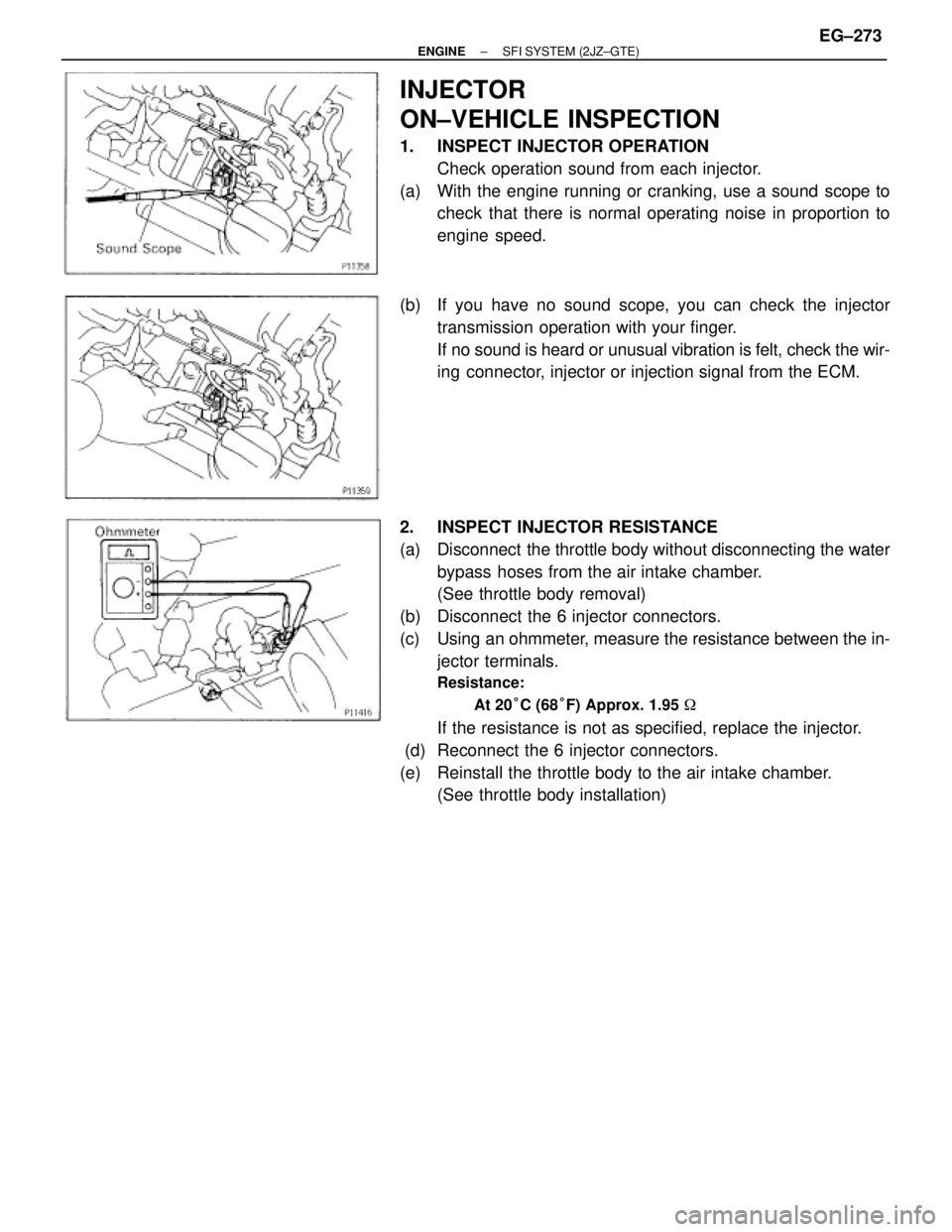
INJECTOR
ON±VEHICLE INSPECTION
1. INSPECT INJECTOR OPERATION
Check operation sound from each injector.
(a) With the engine running or cranking, use a sound scope to
check that there is normal operating noise in proportion to
engine speed.
(b) If you have no sound scope, you can check the injector
transmission operation with your finger.
If no sound is heard or unusual vibration is felt, check the wir-
ing connector, injector or injection signal from the ECM.
2. INSPECT INJECTOR RESISTANCE
(a) Disconnect the throttle body without disconnecting the water
bypass hoses from the air intake chamber.
(See throttle body removal)
(b) Disconnect the 6 injector connectors.
(c) Using an ohmmeter, measure the resistance between the in-
jector terminals.
Resistance:
At 20°C (68°F) Approx. 1.95 �
If the resistance is not as specified, replace the injector.
(d) Reconnect the 6 injector connectors.
(e) Reinstall the throttle body to the air intake chamber.
(See throttle body installation)
± ENGINESFI SYSTEM (2JZ±GTE)EG±273
Page 265 of 878
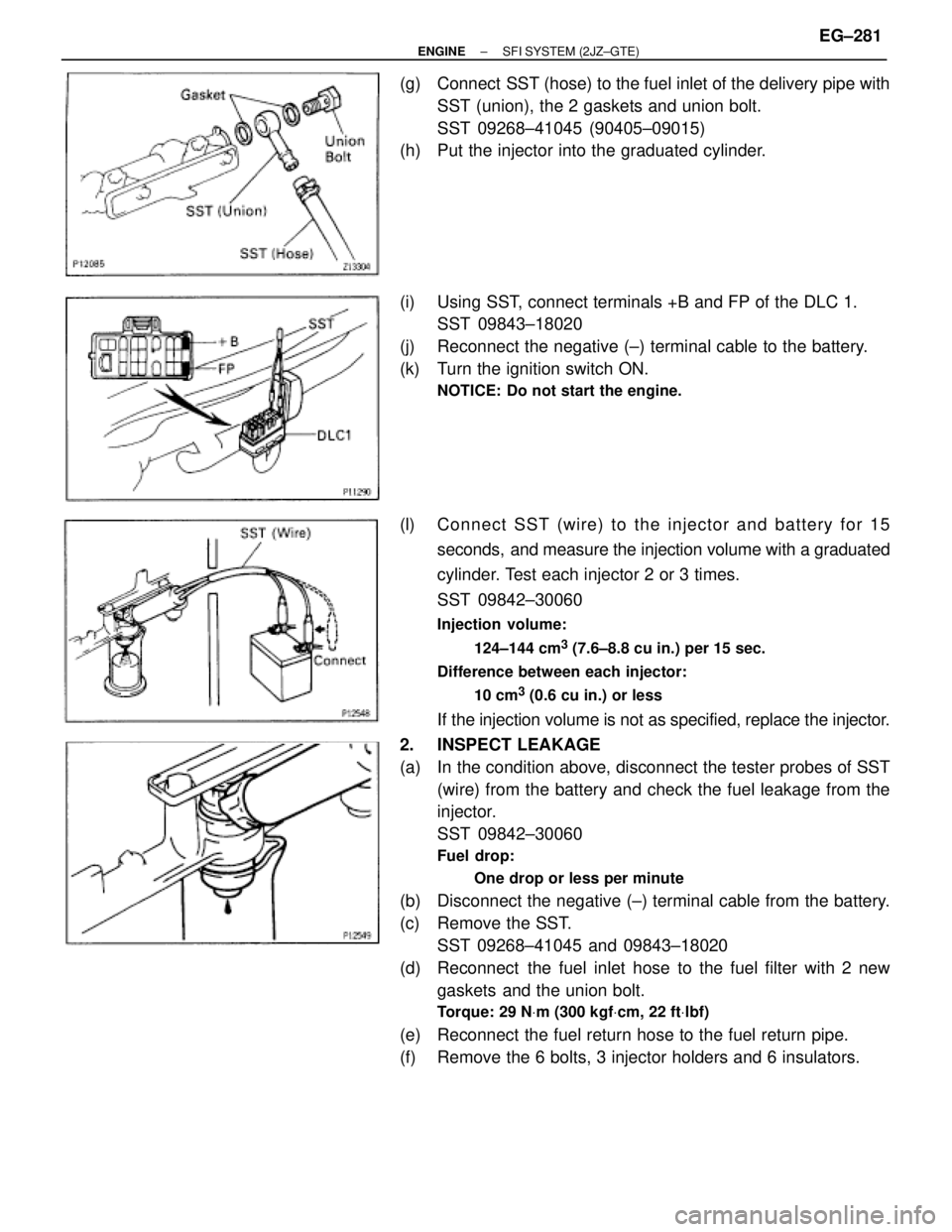
(g) Connect SST (hose) to the fuel inlet of the delivery pipe with
SST (union), the 2 gaskets and union bolt.
SST 09268±41045 (90405±09015)
(h) Put the injector into the graduated cylinder.
(i) Using SST, connect terminals +B and FP of the DLC 1.
SST 09843±18020
(j) Reconnect the negative (±) terminal cable to the battery.
(k) Turn the ignition switch ON.
NOTICE: Do not start the engine.
(l) Connect SST (wire) to the injector and battery for 15
seconds, and measure the injection volume with a graduated
cylinder. Test each injector 2 or 3 times.
SST 09842±30060
Injection volume:
124±144 cm
3 (7.6±8.8 cu in.) per 15 sec.
Difference between each injector:
10 cm
3 (0.6 cu in.) or less
If the injection volume is not as specified, replace the injector.
2. INSPECT LEAKAGE
(a) In the condition above, disconnect the tester probes of SST
(wire) from the battery and check the fuel leakage from the
injector.
SST 09842±30060
Fuel drop:
One drop or less per minute
(b) Disconnect the negative (±) terminal cable from the battery.
(c) Remove the SST.
SST 09268±41045 and 09843±18020
(d) Reconnect the fuel inlet hose to the fuel filter with 2 new
gaskets and the union bolt.
Torque: 29 NVm (300 kgfVcm, 22 ftVlbf)
(e) Reconnect the fuel return hose to the fuel return pipe.
(f) Remove the 6 bolts, 3 injector holders and 6 insulators.
± ENGINESFI SYSTEM (2JZ±GTE)EG±281
Page 268 of 878
(b) Using SST, tighten the pulsation damper.
SST 09612±24014 (09617±24011)
Torque:
41 NVm (420 kgfVcm, 30 ftVlbf)
35 NVm (350 kgfVcm, 25 ftVlbf) for SST
HINT: Use a torque wrench with a fulcrum length of 30 cm
(11.81 in.).
2. INSTALL STARTER
(See starter installation in Starting System)
4. CHECK FOR FUEL LEAKS
(See item 5 in fuel system in precaution) EG±284
± ENGINESFI SYSTEM (2JZ±GTE)